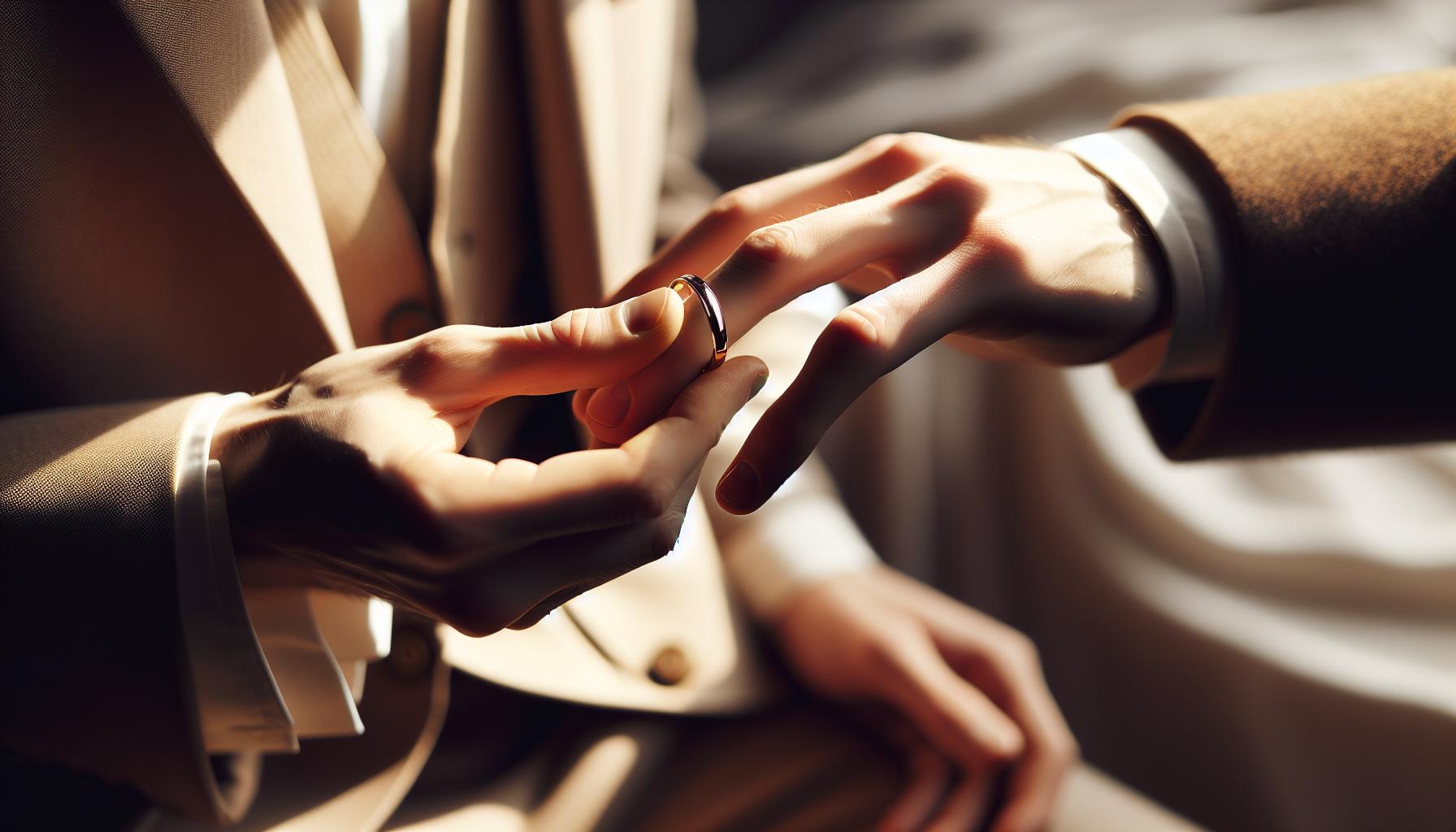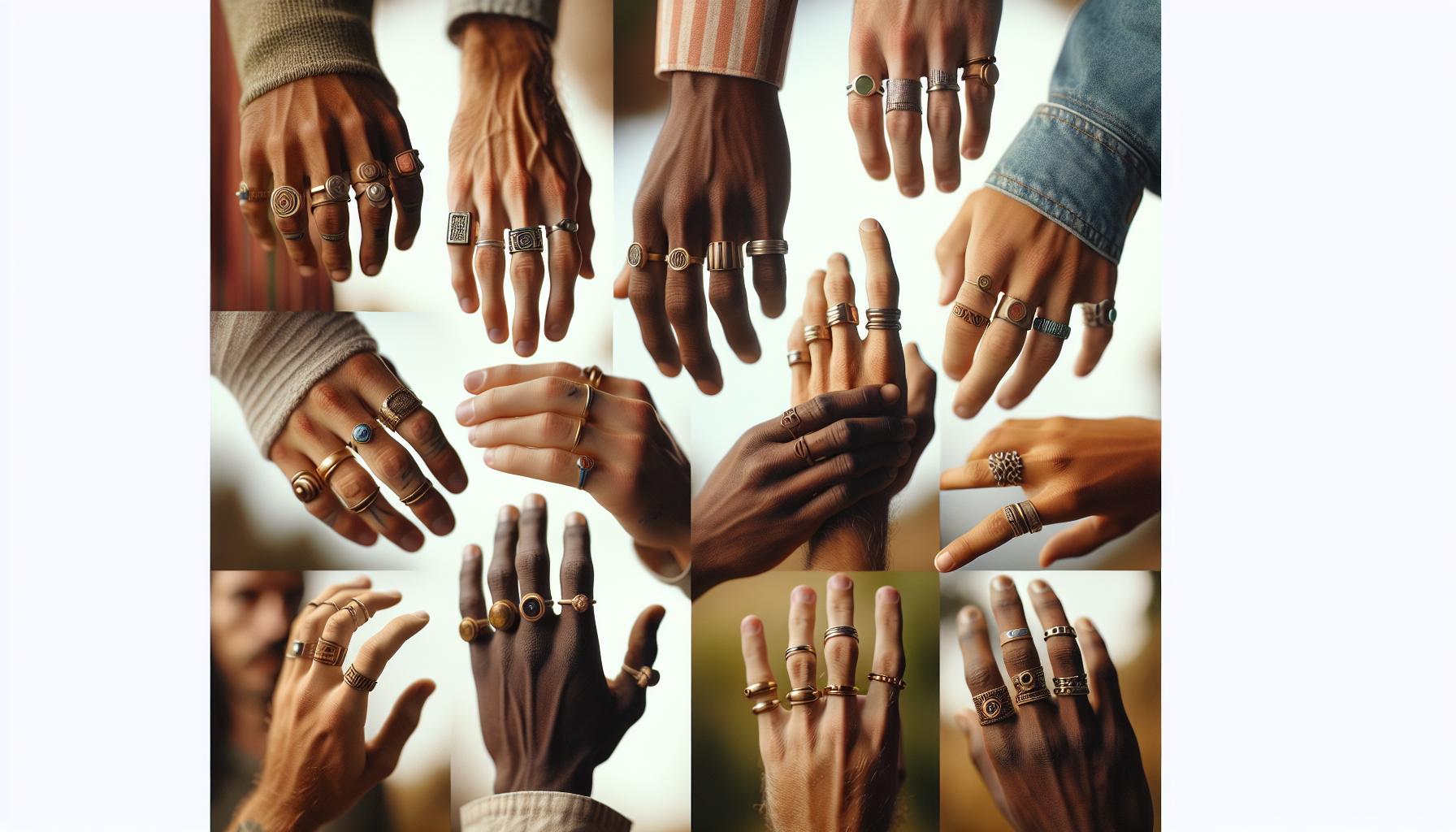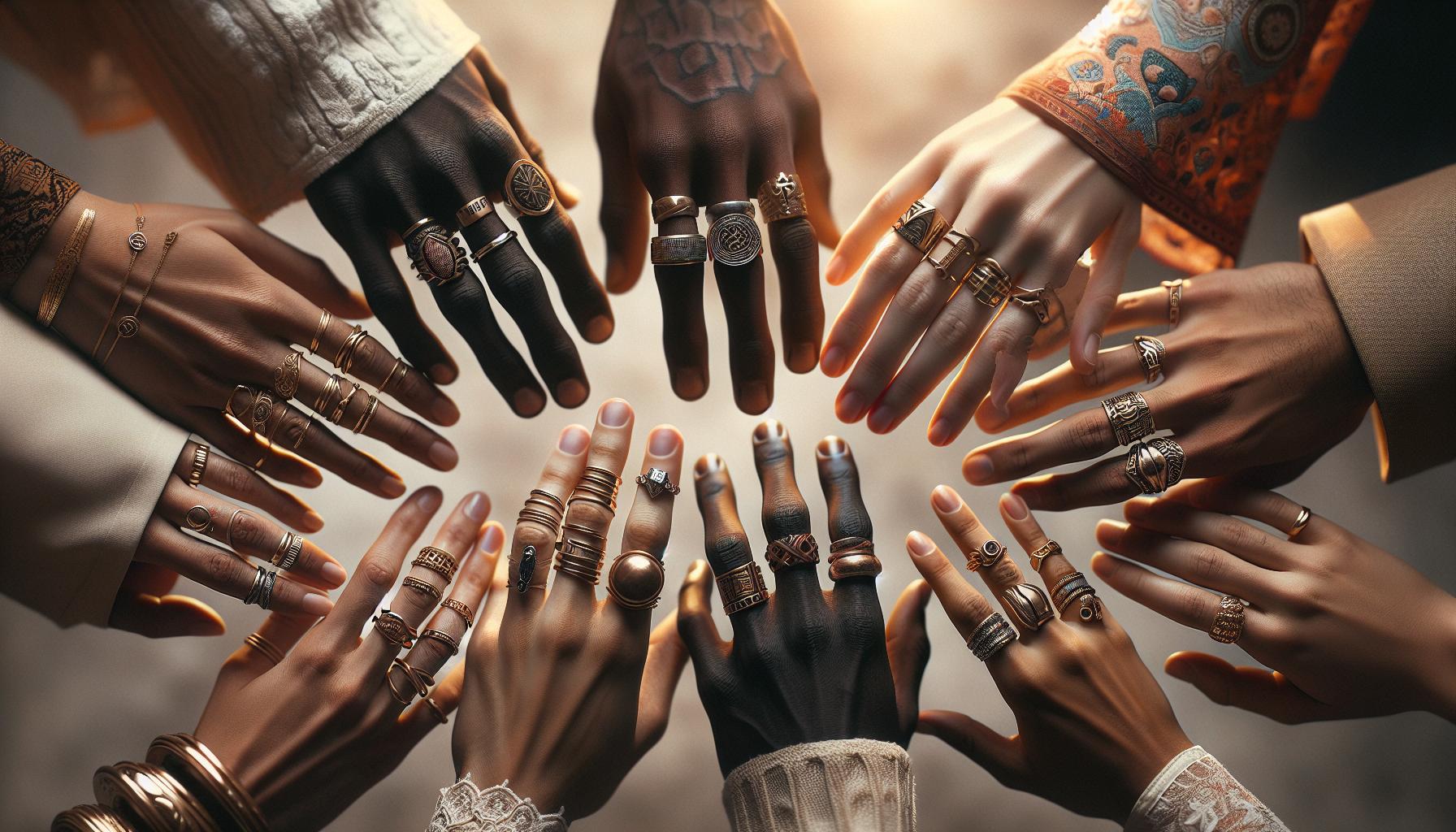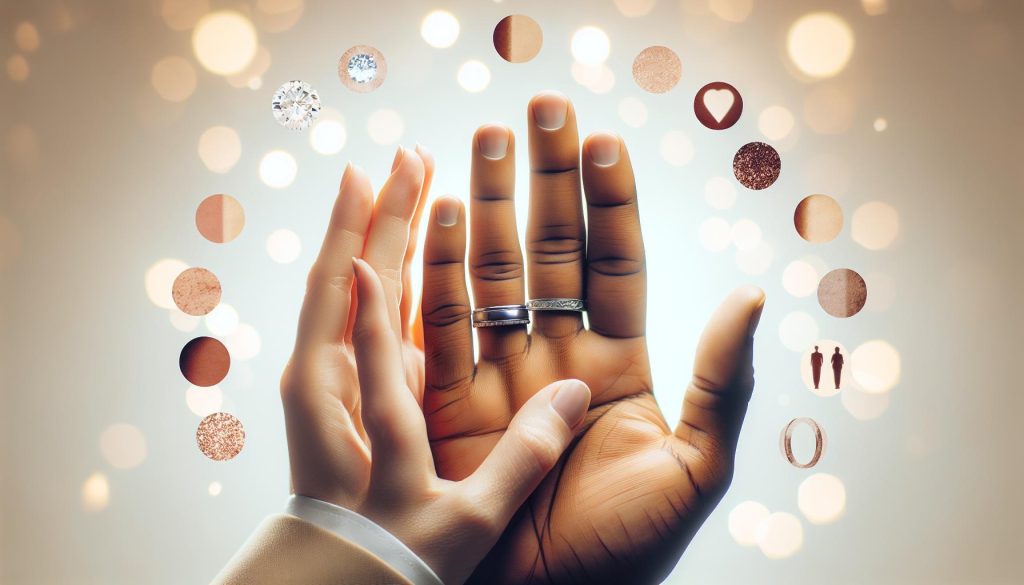When it comes to wedding rings, understanding where to place the wedding band in relation to the engagement ring is not just a matter of aesthetics; it’s rooted in tradition and symbolism. Many couples find themselves pondering this detail, which can affect how they wear their rings for years to come. Proper ring placement not only ensures that your rings look beautiful together but also honors the significance of your commitment. By knowing the etiquette behind ring placement, you can navigate this important aspect of your wedding day with confidence. Dive into this guide to explore the best practices for ring positioning, and discover how to showcase your love story through the exquisite display of your wedding band and engagement ring.
Choosing the Right Finger for Your Wedding Band
When it comes to selecting the right finger for your wedding band, the decision goes beyond mere aesthetics; it often reflects cultural traditions, personal preferences, and sometimes even practicality. Traditionally, in many Western cultures, the wedding band is placed on the fourth finger of the left hand, known as the “ring finger.” This custom is rooted in the belief that a vein called the “vena amoris” runs directly from this finger to the heart, symbolizing eternal love and connection. While this tradition holds strong for many, it’s essential to consider individual circumstances that might influence finger choice.
Some couples opt for alternative placements based on personal significance or cultural traditions. For example, in certain countries, like Greece and Russia, it is customary to wear wedding bands on the right hand. Additionally, those who regularly work with their hands or have specific jobs may choose to wear their rings on their right hand or to a different finger to prevent damage or discomfort. It’s also common for individuals who have previously been married to have different preferences regarding finger placement; they might choose to wear their new wedding band differently to signify the new beginning in their marriage.
Whatever finger you decide upon, it’s crucial to ensure a perfect fit. The ring should feel comfortable and secure without being too tight to remove during times of increased swelling, like in warmer weather. Take into account various factors, such as ring width and personal comfort, which can influence the overall wearing experience. Consulting with a jeweler for sizing and options may provide additional guidance and help ensure your chosen wedding band serves as a cherished symbol of your love for years to come.
Understanding Ring Placement Traditions
In the journey of love and commitment, the placement of wedding bands carries profound significance, echoing centuries of tradition and cultural beliefs. While many couples in Western societies adhere to the custom of adorning the fourth finger of the left hand-often referred to as the “ring finger”-this practice is more than a mere fashion statement. It’s rooted in the ancient notion that this finger houses the “vena amoris,” the vein of love, believed to connect directly to the heart. This symbolism not only enhances the romantic essence of the wedding band but also solidifies its role as a cherished token of everlasting love.
However, wedding ring traditions vary widely across cultures, offering a rich tapestry of practices from which couples can draw inspiration. For instance, in countries like Greece and Russia, it is customary to wear wedding bands on the right hand, emphasizing a different cultural interpretation of partnership and commitment. Other couples may choose placements based on personal significance or practical considerations, such as those who frequently engage in manual labor opting for alternative fingers to better protect their rings from wear and tear. Ultimately, the choice of finger can symbolize a myriad of meanings unique to each couple’s journey, reflecting their values, heritage, and individual circumstances.
As you embark on this exciting chapter of your life, exploring these diverse traditions can be a wonderful way to make your wedding band placement feel even more personal. Consider discussing these options with your partner, taking into account what feels most meaningful for both of you. Whether you adhere to tradition or carve out your own path, the right placement of your wedding band can enhance the emotional resonance of this precious symbol, reminding you daily of the love and promise you share. Adjusting your choice to reflect your personal narrative and commitments ensures your wedding band not only fits well but also serves as an enduring emblem of your unique story.
How to Stack Your Engagement Ring and Wedding Band
Before you slip on your wedding band, consider the enchanting dance of rings that will grace your finger. Stacking your engagement ring and wedding band isn’t merely about aesthetics; it’s a celebration of your journey, intertwined symbols of love that deserve thoughtful consideration. Achieving a harmonious blend often comes down to choice of styles, shapes, and personal preference, transforming your hand into a canvas of love and commitment.
To create the perfect stack, begin by evaluating the design of your engagement ring. If it features intricate settings or embellishments, a simpler wedding band can accentuate its beauty without overwhelming it. Conversely, if your engagement ring is minimalist, don’t shy away from a bolder wedding band adorned with gemstones or intricate details. When trying on rings, consider how they sit together; they should complement each other without feeling cramped.
Another important aspect is the order of rings. Traditionally, the wedding band is placed closest to the heart, followed by the engagement ring. This setup symbolizes the foundation of your love being first and foremost, followed by the commitment represented by your wedding band. You can also mix and match metals-like pairing a gold engagement ring with a platinum wedding band-to highlight both pieces uniquely. Ultimately, listen to what resonates with you as a couple; whether it’s coordinating styles, merging metals, or even stacking with other meaningful rings like family heirlooms, there are no hard and fast rules. The most important thing is that your stack tells your love story, one beautiful ring at a time.
By embracing the endless possibilities of how to stack your rings, you not only celebrate your union artistically but also create a stunning representation of your love’s journey through life together.
The Significance of Ring Placement in Different Cultures
The heartfelt tradition of placing rings is deeply intertwined with cultural significance, reflecting the values and beliefs that influence the joining of two lives. Across various societies, where and how you wear your wedding band might carry profound meanings, transforming a simple piece of jewelry into a symbol rich with history and emotion.
In many Western cultures, it is customary to wear the wedding band on the fourth finger of the left hand, often referred to as the “ring finger.” This tradition dates back to ancient beliefs that a vein, the “vena amoris,” runs directly from this finger to the heart, symbolizing the deep emotional connection between partners. In contrast, other cultures-such as many Eastern European and some Asian traditions-prefer to wear wedding bands on the right hand, which can signify different cultural values surrounding love and commitment.
Cultural diversity extends to the style and symbolism attached to wedding bands as well. For example, in the Jewish tradition, a simple gold band is often used to represent the unbroken nature of the couple’s commitment. Conversely, in Indian culture, the “mangalsutra” is worn by brides after marriage as a sacred symbol of love and union, highlighting the balance of tradition and personal expression in matrimonial practices.
Additionally, understanding these varied customs can enrich your own wedding experience. Couples may choose to honor their heritages by adopting meaningful practices from their backgrounds, or they may create new traditions that blend their cultures. No matter the placement or style, each ring worn on the finger tells a unique story of love, commitment, and shared futures, encouraging couples to consider the significance behind their choices. Embracing these insights not only elevates the experience of choosing rings but also allows each couple to celebrate their love in a way that resonates deeply with their values and identity.
Tips for Comfortable Wedding Band Wear
Wearing a wedding band shouldn’t just be a beautiful experience; it should also be a comfortable one. After all, this symbol of your love and commitment will likely be on your finger every day for years to come. To ensure the greatest comfort, pay attention to several important factors that can make a significant difference in how your ring feels.
Choosing the right size is the first crucial step. A wedding band that is too tight can cause discomfort and even restrict blood flow, while one that is too loose risks slipping off during daily activities. To find the perfect fit, it’s best to have your finger measured at the end of the day when it is at its largest due to natural swelling. Consider the width of the band as well; wider rings may require a slightly larger size to accommodate the extra material around your finger.
Another aspect to keep in mind is the band’s material. Various metals can offer different levels of comfort. For example, platinum is exceptionally durable but can be quite heavy, while gold bands are available in multiple karats and can provide a lighter feel. Titanium and tungsten are modern options that are incredibly strong yet surprisingly lightweight. If you have sensitive skin, ensure that the band is hypoallergenic to prevent irritation.
Lifestyle considerations also play a vital role. If you lead an active lifestyle or work with your hands often, opt for a design that is low-profile with rounded edges to prevent snagging or discomfort. Some couples even choose to engrave personal messages on the inside of the band, creating an extra layer of sentimentality while ensuring no sharp edges are present on the outside.
Finally, remember that your wedding band should feel like a natural extension of yourself. Wearing it should bring feelings of joy and connection rather than discomfort. Regularly check the fit, especially during seasonal changes when fingers may swell or shrink, and consult a jeweler for resizing if necessary. Your wedding band is not just a piece of jewelry; it’s a cherished symbol of love, commitment, and shared moments. Making a thoughtful choice about comfort will allow you to wear it proudly and comfortably for years to come.
What to Consider When Choosing Wedding Band Placement
The placement of your wedding band is more than just a matter of aesthetics; it symbolizes the profound bond you share with your partner. Traditionally, the wedding band is worn on the fourth finger of the left hand, often referred to as the “ring finger.” This practice stems from the ancient belief that a vein, dubbed the “vena amoris” or vein of love, runs directly from this finger to the heart. While this beautiful notion persists, it’s essential to consider various factors when determining the best placement for your wedding band.
One important consideration is the stacking order of your rings. Many choose to wear their wedding band closest to their heart, placing it directly on the finger before the engagement ring. This arrangement not only maintains a visually harmonious look but also aligns with the sentimentality of your wedding band as the ultimate symbol of commitment. However, some prefer the engagement ring on top, showcasing its significance while allowing the wedding band to complement it. Whichever order you choose, make sure that both rings fit comfortably together without causing any irritation or discomfort.
Another factor to ponder is your lifestyle and activities. If you engage in physical work or sports, you may want to explore alternative placements, such as wearing your wedding band on the right hand or opting for a lightweight design that won’t interfere with your daily activities. Additionally, some couples decide to wear their wedding bands on a necklace or in a personalized ring holder on special occasions, making it a unique representation of their love while allowing for flexibility in their daily lives.
Inclusivity in ring placement is also vital; for same-sex couples, the beauty of personalization allows you to choose any finger that resonates with your relationship. The placement can reflect your unique love story, whether choosing matching designs or showcasing individual styles. Ultimately, your wedding band placement should reflect your connection and be a constant reminder of the love you share. Embrace this exciting journey, and remember, there are no hard and fast rules-only the sparkling joy of your commitment to one another!
Engagement Rings vs. Wedding Bands: Placement Differences
The journey of selecting and placing your engagement ring and wedding band can feel like a merging of personal styles and traditions. Understanding how these two rings are traditionally worn and perceived can help you create a beautiful representation of your love story. Generally, engagement rings are designed to stand out, often featuring intricate designs and a prominent gemstone, symbolizing the promise of love and commitment. In contrast, wedding bands are traditionally simplified bands, often plain, and meant to be a lasting symbol of your vows. Their differences extend not just in aesthetics but also in how they are typically worn.
When it comes to placement, tradition primarily encourages the wedding band to be worn closest to the heart-right on the finger before the engagement ring. This arrangement places the wedding band, the symbol of your enduring commitment, nearest to your skin, followed by the engagement ring, which represents the promise of that commitment. Some, however, choose to wear the engagement ring on top, allowing it to take prominence, which can be particularly appealing if it features a larger gem or intricate design that you want to showcase. It’s all about what feels right for you as a couple.
In contemporary practices, there are no strict rules, and personal preference reigns supreme. For example, some couples opt to wear their wedding bands on their right hands instead of the traditional left, perhaps due to cultural influences or simply because it feels more comfortable. Additionally, lifestyle factors play a significant role; for those who lead active lives, a more minimalist wedding band that sits snugly against the skin may be preferable, allowing for ease of movement without compromising on style.
Ultimately, the real magic lies in how these rings reflect your unique bond. Whether you stack them traditionally or express your individuality through their placement, each arrangement symbolizes the beautiful union you are forging together. Embrace the moment as you create not just a wearable piece of jewelry but a lasting token of your love that honors both tradition and personal expression.
Caring for Your Wedding Band in the Long Run
Caring for your wedding band is essential not only for maintaining its beauty but also for preserving the emotional significance it holds as a symbol of your love and commitment. Keeping it in pristine condition allows you to enjoy its timeless elegance for years to come, enhancing the way it reflects your journey together as a couple. With some simple and regular care, your wedding band can continue to shine brightly through the decades.
To ensure your wedding band remains as stunning as the day you exchanged vows, consider these practical care tips:
- Regular Cleaning: Depending on the material of your wedding band, cleaning methods may vary. For gold or platinum bands, gently scrub with mild soap and warm water using a soft toothbrush to remove dirt and oils. Rinse thoroughly and dry with a soft cloth.
- Avoid Harsh Chemicals: Household cleaners can damage the finish or integrity of your ring. Remove your ring when using cleaning products or engaging in activities involving heavy chemicals.
- Secure Storage: When not wearing your wedding band, store it in a fabric-lined jewelry box or pouch to prevent scratches from other pieces. Avoid leaving it on surfaces where it can easily be knocked off or lost.
- Professional Maintenance: Scheduling regular check-ups with a jeweler can help assess the condition of your ring. They can check for loose stones or signs of wear that might require repairs.
Embracing the emotional aspect of your wedding band also means taking the time to appreciate its significance in your love story. Whether you wear it daily or on special occasions, regularly reflecting on its meaning can enhance its sentimental value. As you care for your wedding band, each cleaning and maintenance session becomes a ritual in itself, reinforcing the love and commitment it represents.
Remember that your wedding band is more than just an accessory; it is a celebration of your journey together and a testament to your shared experiences. By dedicating time to care for it, you are not only preserving its physical beauty but also honoring the memories and milestones it symbolizes. With thoughtful maintenance, your wedding band can continue to tell your love story for years to come.
The Emotional Aspect of Wearing Your Wedding Band
Every time you glance at your wedding band, you are reminded of the promises made and the journey you are embarking on together. The emotional connection to your wedding band extends far beyond its aesthetic appeal; it represents a tangible link to love, commitment, and the future you envision. As you choose the finger for your wedding band and contemplate its placement, consider how this simple act enhances the emotional significance of your ring.
Where you wear your wedding band can carry deep meaning, influencing how you express your love and commitment. Traditionally, many choose to place their wedding band on the fourth finger of the left hand, often called the “ring finger,” believed to have a vein directly connected to the heart. This placement symbolizes the deep bond between partners, reinforcing the sentiment that love is at the center of your relationship. Whether you wear your band above or below your engagement ring, this small yet profound choice connects you to countless couples through history, uniting your love story with theirs.
Consider also the emotional weight of wearing your band. Each time you slide it on, you are reminded of your vows, the shared experiences, and the adventures that await you. This ring will witness milestones in your life-birthdays, anniversaries, and everyday moments-which creates a narrative unique to you as a couple. To enhance this emotional connection, take time to cultivate rituals around your wedding bands. For instance, why not share your reflections together on anniversaries? Discuss what your ring symbolizes and how it resonates with your life journey, deepening the bond you share.
Ultimately, wearing your wedding band becomes a personal expression of love, celebrated in various ways by different cultures and individuals. Whether it’s through symbolism in placement, the story of your relationship, or the way you cherish shared moments, your wedding band can embody all the love and devotion you bring to your union. So, as you navigate the choices surrounding your wedding band, embrace the emotional aspect it represents, cultivating a tangible reminder of your journey together.
Common Mistakes in Wedding Band Placement
Selecting the perfect finger for your wedding band is more than just a matter of aesthetics; it can significantly impact the overall symbolism and comfort of wearing it. Many couples overlook common pitfalls that could affect how their wedding bands are worn and perceived over time. Being mindful of these missteps can help ensure that your ring placement enhances your love story rather than complicates it.
One frequent mistake is placing the wedding band incorrectly in relation to the engagement ring. Traditionally, it is advisable to wear the wedding band closest to the heart, which means it should sit on the ring finger beneath the engagement ring. This arrangement not only symbolizes the wedding band’s role as a commitment to your partner but also protects the engagement ring from potential damage. Failing to consider this layering can result in a less meaningful display of your love, as well as potential wear and tear on your rings.
Another pitfall to avoid is selecting a size that doesn’t accommodate fluctuating finger sizes. Many may not realize that factors like heat, humidity, and even time of day can affect finger width. Choosing a band that’s too loose may lead to the ring slipping off, while one that’s too tight can cause discomfort. If the band is designed with intricate details, it may feel snug when your fingers swell. Seek the guidance of a jeweler who understands these nuances, ensuring your band fits perfectly at various times.
Emotional attachment can also lead to mistakes; couples may hesitate to wear their bands regularly out of fear of losing or damaging them, missing out on the meaning encompassed in daily wear. Making a conscious decision to wear your wedding band allows it to become a touchstone for affection and commitment. Establishing routines around when and how you wear your rings can enhance this connection, making your wedding band a cherished part of daily life rather than just an occasion-specific accessory.
Additionally, cultural differences can influence perceptions of ring placement. In some cultures, it is common to wear wedding bands on the right hand instead of the left. If couples fail to communicate their traditions, it may lead to misunderstandings or misplaced feelings. Celebrating both perspectives within the relationship can ensure inclusivity and mutual respect, allowing you to blend traditions in a way that best reflects your unique bond.
Ultimately, being aware of these common mistakes can guide you toward meaningful choices regarding your wedding band placement. By embracing thoughtful placement, appropriate sizing, and regular wear while honoring cultural traditions, you’ll reinforce the significance of your wedding band as a cherished symbol of your love story.
Ring Placement for Same-Sex Couples: What to Know
Choosing the right finger for your wedding band is a significant decision, especially for same-sex couples who may wish to establish their own unique traditions in a landscape often dominated by conventional norms. The beauty of love is that it knows no boundaries, and this extends to how couples choose to express their commitment. When it comes to ring placement, each couple can create their own personal meaning that reflects their love story while considering the traditions that resonate most with them.
Traditionally, in Western cultures, the wedding band is worn on the fourth finger of the left hand, also known as the ring finger. However, many same-sex couples choose to redefine this tradition. Some may opt to wear their wedding bands on their right hand, embracing a gesture that reflects both individuality and inclusivity. This choice can symbolize equality, allowing each partner to display their commitment in a manner that feels more authentic to their identities. When deciding, it’s essential for couples to communicate openly about their preferences, as this conversation can lead to a deeper understanding and appreciation of each other’s desires.
- Layering Options: Just like heterosexual couples, same-sex partners can decide how to layer their rings. Some choose to stack engagement rings and wedding bands on the same finger, creating a beautiful visual representation of their journey together.
- Personal Symbols: Couples might also consider custom designs that reflect their relationship. Unique engravings or matching motifs can enhance the emotional connection tied to the ring, making it a more significant representation of their love.
- Shared or Coordinated Bands: Some couples may opt for matching wedding bands or, alternatively, complementary styles that represent their individuality while still signifying their union.
It’s vital that same-sex couples are aware of the emotional aspects tied to ring placement. Wearing a wedding band signifies not just a commitment but also a celebration of love in all its forms. Being intentional about which finger the band is worn on allows couples to share a meaningful narrative with the world, one that celebrates not just their love but the triumph of breaking traditional boundaries. Whether opting for the left or right hand, or choosing innovative styles, the ultimate goal remains the same: to honor the unique bond that connects them, creating a symbol that will last a lifetime.
How Your Wedding Band Tells Your Love Story
The story of your love unfolds not only in the moments you share but also through the symbols you choose to embody that love, such as your wedding band. Each ring carries with it a narrative crafted from personal experiences, chosen designs, and meaningful rituals, reflecting the unique journey that you and your partner have walked together. Wearing your wedding band serves as a daily reminder of your commitment, a token that tells the world about your love story without uttering a single word.
The choice of where to wear your wedding band can further personalize this narrative. For many, placing the band on the fourth finger of the left hand signifies a connection to long-standing traditions, as it’s believed that this finger has a special vein leading directly to the heart. However, modern couples may opt to reinterpret this custom, choosing to adorn their right hands instead or layering rings in a way that represents their individual personalities yet speaks to their unity. This thoughtful placement can convey messages of equality, individuality, and shared commitment, allowing each partner to express their bond as uniquely as their love story deserves.
Consider the craftsmanship and design of your wedding bands as another dimension of your love narrative. Engraving your initials, a special date, or a meaningful quote can infuse your rings with significant emotional weight, transforming them into cherished heirlooms that carry your legacy forward. Whether opting for classic diamond-studded bands or custom-made pieces with personal symbols, each choice lets you articulate the aspects of your relationship that resonate with you both.
Ultimately, your wedding band is more than just a piece of jewelry; it is a tangible expression of your connection, your shared hopes, and your journey together. Embrace the power of this symbol to communicate your love story, reminding yourselves and those around you of the beautiful, unique bond you celebrate every day.
Faq
Q: Where should I wear my wedding band?
A: Your wedding band is traditionally worn on the fourth finger of your left hand, also known as the “ring finger.” This placement symbolizes your commitment and is a common practice in many cultures. For more insights, check out the section on choosing the right finger for your wedding band.
Q: Can I wear my wedding band on my right hand?
A: Yes, wearing your wedding band on your right hand is becoming increasingly popular, particularly in some cultures or if it suits your style better. The most important factor is that it feels comfortable and meaningful to you.
Q: What order do I wear my wedding band and engagement ring?
A: Traditionally, the wedding band is worn closer to the heart, placed directly against the skin, followed by the engagement ring on top. This stacking symbolizes that the wedding band represents your commitment and the engagement ring symbolizes love.
Q: Are there any cultural differences in ring placement?
A: Yes, in some cultures, such as certain Eastern European and Indian communities, wedding rings may be worn on the right hand. Understanding these cultural traditions can add depth to your wedding experience, as discussed in the significance of ring placement in different cultures.
Q: What should I consider when choosing ring placement?
A: When choosing ring placement, consider factors like hand size, daily activities, and personal style. Comfort and symbolism are key; ensure your rings sit securely without irritation. For more tips, look at the section on tips for comfortable wedding band wear.
Q: Is it acceptable to wear the wedding band alone?
A: Yes, wearing your wedding band alone is entirely acceptable, especially if you prefer a minimalist look or during certain activities. Your personal style should dictate how you choose to wear your rings.
Q: How do I prevent my wedding band from spinning on my finger?
A: To prevent your wedding band from spinning, ensure it fits snugly but comfortably. Consider styles with a slightly wider band or textured surfaces that may provide more grip. For more wearing tips, refer to the section on tips for comfortable wedding band wear.
Q: Can I change the placement of my rings for special occasions?
A: Absolutely! Many people choose to adjust their ring placements for special events or outfits. Feel free to explore different styles and placements that reflect your personality and the occasion. For stacking advice, check the section on how to stack your engagement ring and wedding band.
Insights and Conclusions
Now that you’re well-versed in the proper placement of your wedding band, it’s time to put that knowledge into action! Remember, the order of your rings not only reflects your unique love story but also stands as a reminder of your special day. Are you ready to explore more about choosing the perfect rings, understanding wedding traditions, or planning your dream ceremony?
Dive deeper into our resources for everything from ring styles to etiquette tips that ensure your celebration is as flawless as your love. Don’t forget to check out our comprehensive guide on wedding essentials and consider signing up for our newsletter for exclusive tips and inspiration that will make your planning journey enjoyable and memorable. Your wedding is just the beginning-let’s make every detail extraordinary!











